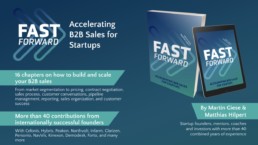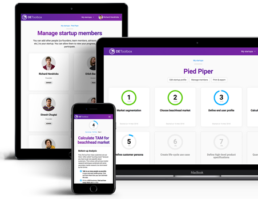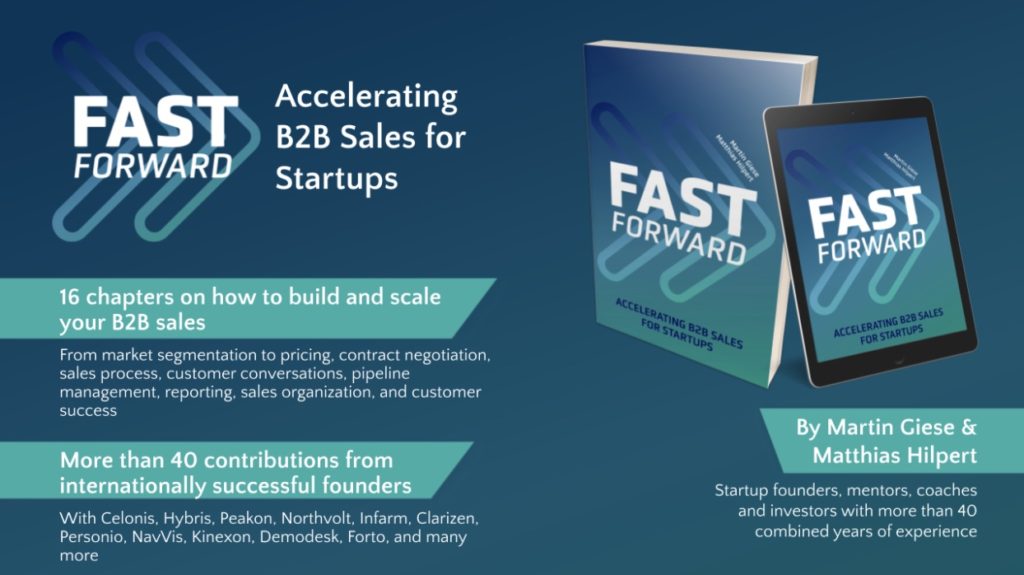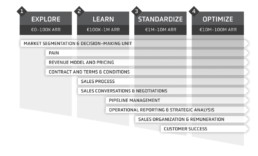The Decision-Making Unit: The Who-is-Who of Your B2B Sales Process
The Disciplined Entrepreneurship Toolbox
Stay ahead by using the 24 steps together with your team, mentors, and investors.
Sign up for our newsletter
The challenge in B2B sales is that a company is not a single entity, like an actual human. It’s not the company that decides on buying your solution – it’s the humans within the company. And these humans can have conflicting interests and perspectives regarding your product.
In order to successfully sell to your target companies, you need to understand how the humans within the companies typically make purchasing decisions.
There are a lot of roles you may interact with during a typical B2B sales process. On an organization chart, your interactions during the process may look something like this:
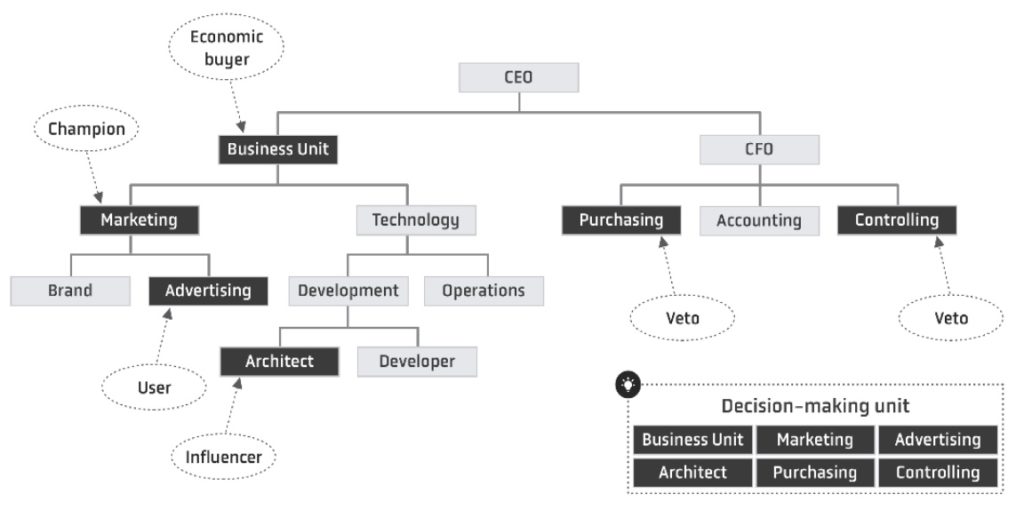
Let’s look at those different roles in detail.
How to find the decision-making unit
In order to identify the relevant players in their specific context, Martin regularly refers the startups in his incubator to the “decision-making unit” framework by entrepreneurship professor Bill Aulet, the bestselling author of “Disciplined Entrepreneurship.”
The three primary roles in the decision-making unit
Bill Aulet advises founders to look for three primary roles in their target companies: End Users, Champions, and Primary Economic Buyers.
- The End User is the person who will actually use your product or service. The End User always plays a significant role in the buying decision.
- The Champion is the person who wants the customer to purchase your product. He may be the End User, but not necessarily so.
- The Primary Economic Buyer is the person in the company who can sign off on the money required to purchase your product.
To identify the decision-making unit, zoom in to your target segment. The basic assumption is that all three primary roles exist in one form or the other at every potential customer.
How to find out the decision-making units in the companies within your target segment
Ask questions. This is simple but powerful advice from Bill Aulet. Once you have a first person at your target company engaged, leverage the opportunity to ask them your questions:
- What would we need to do to bring our product in for a test?
- Who, besides you, needs to be involved in the decision?
- What could stop this from happening?
- Who controls the budget?
Be straightforward. Ogynan Vasilev from Salesforce encourages founders to not beat around the bush. If you’re not sure whether the person you have been talking to has the power to actually make a purchasing decision – just ask them. In most cases, they will give you a straightforward answer: “We need this one manager to be involved to decide.”
Champion and End User
The person you expect to be your Champion should be the first target to contact within a prospective customer.
Identifying your Champion’s typical role
Often your Champion will be an End User with a direct interest in the solution you are proposing:
It turned out that the person with the biggest pain was the easiest to approach. So we always tried to enter the organization bottom-up by finding a Champion for our solution.
It is good practice to describe Champions and other roles in a comprehensive “persona” – an illustrative description of the target person that describes his or her typical hierarchical position in the organization, their responsibilities, their targets, job titles, needs and fields of interest.
Creating personas will help you, and later your team, to search for and recognize the right kind of contacts within a larger organization.
Finding the right person in a specific company
Traditionally, calling the company headquarters and asking who might be the right person to talk to about your product was the #1 approach to get in touch (and it’s still a great idea).
Today, many employees especially in high-tech and digital industries are active on LinkedIn or similar professional networks. Whether you call or hunt on LinkedIn – be creative in your detective work:
For our first customer, it was important to understand their particular organizational structure. As a big corporation, they have unique roles and management levels. Some of the names at the top level were publicly known. We had also found a career website where they described their career levels, which we then compared to the job titles in the email signature to find out what level we were talking to. This is how we worked us in from the bottom up and from the top down at the same time.
While the Champions and End Users do not eventually make the actual purchasing decision, our experience shows time and again that the advocacy of these stakeholders can make a real difference in “winning the war,” especially if there are conflicting interests within the company.The strategic importance of Champions
In adding to the strategic component of identifying a Champion, Stephan Rohr of TWAICE further expands on the aspect of “emotional connection” to your Champion and highlights it as the crucial component of your sales effort:
Particularly in B2B, you need a champion who you’re having an emotional relationship with. He or she will have to overcome internal hurdles. And he or she wants to be able to sign your deal without having to worry that their head will be the first to roll because something went wrong. Especially when in the beginning, there won’t be any references with other big clients they can hide behind.
Ognyan Vasilev of Salesforce points out a typical pitfall for founders, especially in startups with highly technical solutions:Primary Economic Buyer
Startups often find it easy to connect with experts who understand their product and are excited about the tangible improvements it brings. However, these are often not the ones that will take the final decision on adopting the solution.
Keep in mind, too, that there are different levels of decision-making power within the same organization. Trying to sell a product of €100,000 to a department head who is not authorized to make this decision is a waste of time – and one of the most common mistakes founders make. For this reason, never focus solely on working with technical experts and R&D teams. After getting a foot into the door on the technical level, always try to get introduced to the economic decision-makers.
Identifying the typical Primary Economic Buyer role
If you are trying to find out who the Primary Economic Buyer of your product is, it helps to look at the organizational chart, as budget control is typically closely related to hierarchy. This will also help design the right marketing messaging for convincing the stakeholder at the relevant decision-making level.
Additional roles
While the primary roles are quite intuitive, it is important to understand additional roles that you may encounter. These are:
- Influencers – These are people who have the power to influence other decision-makers, based on their experience or standing within the company. They can reside either inside the company or outside; for example, in media publications, industry groups, or consultancies.
- Veto Powers – These stakeholders are particularly dangerous for you. In corporate settings, veto power can be based on hierarchy, but also on function. For example, the IT department may have veto power over any software or hardware purchase.
- Purchasing Department – Starting from a certain corporate size, you will encounter this department. It is focused on handling the entire purchasing process and famously aims to drive prices down. In general, think of them as a link in the chain that you should neutralize, but not actively sell to.
Keep the Big Picture in mind
A subconscious bias in the minds of many founders (and indeed many sales trainers) is the idea that you just need to know how to lead successful “sales conversations,” that is, how to talk to people to convince them to buy your product.
But as Robert B. Miller and Stephen E. Heiman already pointed out in their classic “Strategic Selling”: your strategy can only begin once you know who the players are.
Selling innovation to enterprise customers (business-to-business or B2B sales) is one of the toughest nuts for startup founders to crack. This text builds on the book Fast Forward: Accelerating B2B Sales for Startups. In their book, authors Matthias Hilpert, Investor, and Martin Giese, Business Angel and Startup Coach, share their insights from 40 years of operational experience and from interviews with 32 internationally successful founders from companies like Celonis, Northvolt, and Peakon. The accompanying teaching materials are available for free here on the Disciplined Entrepreneurship platform.
The authors
Martin Giese & Matthias Hilpert
Martin is a business angel, startup coach, negotiation expert, and author of the "Startup-Finanzierung" books. Matthias is one of the top 30 angels backed by EIF in Germany and has studied Business, Philosophy, and Artificial Intelligence.

The books
This methodology with 24 steps and 15 tactics was created at MIT to help you translate your technology or idea into innovative new products. The books were designed for first-time and repeat entrepreneurs so that they can build great ventures.
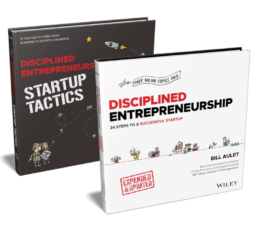
Why Startup Founders Can't Outsource Their First B2B Sales
The Disciplined Entrepreneurship Toolbox
Stay ahead by using the 24 steps together with your team, mentors, and investors.
Sign up for our newsletter
Many B2B startup founders try to outsource sales to “experts” very soon.
In a way, that’s understandable: If you have no IT background, you wouldn’t presume to tell your software engineer how to code your product. So why would you try to sell your product yourself if you have no experience in sales? The difference is: As a founder trying to get a B2B business off the ground, it is your responsibility to get customers to buy your product.
There are three reasons why a sales focus is essential for founders:
1. No sales = no startup
The survival chance of your startup depends on a pass-or-fail question: are there paying customers? Naturally, if your startup is just launching, you won’t have full-order books yet. In the early stages, it might also make sense to collaborate with your customers, in exchange for their investment in co-development or the data and access they are giving you.
At some point, though, there’s no way around it: You need a paying customer. Nothing else – not a great product, not an amazing team, not a pile of awards – is proof that you are on the right track. By definition, having someone who buys your stuff is the one necessary condition required to running a company. And to get companies to buy from you, you need sales.
Without founder sales, there’s no product discovery. And without product discovery, there’s no product/market fit.
2. The secret window into your customers’ brains
Without sales, there is no way to know what your customers actually think about your product.
As you are building your product, you want to make it as useful as possible for your future customers. But how do you know what is useful to them?
No matter how much you think you know about your customer (for example, from your own industry experience), you will only know the full picture if you enter into an actual conversation with them. And no conversation is as effective as a sales conversation – talk is cheap, but a sale is proof that you’ve struck a nerve.
This is an essential part of why sales is so important (and in our view: why it’s so much fun!) particularly in the early stages of your startup. The conversations and interactions you will have during the sales process will deliver key information that you can use to develop your product and technology. In the later stages, the information helps you with strategic planning, expanding and diversifying your growing company.
In B2B, there is no alternative to founder sales. Today, we have hundreds of employees and I’m still in on every OEM sale. Not because I want to micromanage it, but because I need to know what keeps the customer awake at night. Otherwise, I risk losing touch with the market.
3. Investors love startups who can sell
Without sales, it’s hard to gain the traction necessary to convince investors of financing your startup.
Like other investors, we have a long list of criteria such as team quality, market size and type, and product execution when we’re evaluating an investment in an early-stage startup. What we are looking for is proof that your startup has the potential for fast growth.
The one criterion that trumps all others is customer traction or – even better – revenue traction. If you can prove that you are successful in selling your product to paying customers, you are well on your way to a “yes” from investors.
Why you can do sales regardless of your background
Early sales is different because it’s all about establishing a continuous feedback loop between your business model, your product, and your customer. Like a spider in the web, only you are in the central position necessary to successfully sell in the beginning. Only later on will you need a sales organization to scale what you have begun.
Sales is such an essential area of your business. You can’t just hand it off to someone else. As a founder, you have to go through the process yourself to understand it. In the beginning, sales is a very entrepreneurial activity. How do you find someone with a need? How do you get their contacts?
If you’re like most startup founders, you will have no experience in sales from university or your previous career. You’re in good company: Like many founders who end up doing a lot of sales for their startup, we also did not start our careers in sales based on any sales-specific academic background.
We hadn’t even been especially eager to get into sales. In Europe, sales doesn’t always have the best image. At the very best, some salespeople are admired as “sales wizards” – natural charmers who can mystically woo customers into buying anything. But for the most part, “sales reps” are seen as annoying pests who see sales as a game of grit: if you just knock on enough doors, you can sell sand in a desert.
Only once we got into the field, we changed our view on the profession completely. That’s when we found out that reducing sales success to charm or grit, however, disregards one fundamental truth:
Salesmanship can be learned like any other discipline.
Over time and with experience, what appears like intuition reveals itself to be a logical result, based on established principles and truths. Sales is more math than magic.
Selling innovation to enterprise customers (business-to-business or B2B sales) is one of the toughest nuts for startup founders to crack. This text builds on the book Fast Forward: Accelerating B2B Sales for Startups. In their book, authors Matthias Hilpert, Investor, and Martin Giese, Business Angel and Startup Coach, share their insights from 40 years of operational experience and from interviews with 32 internationally successful founders from companies like Celonis, Northvolt, and Peakon. The accompanying teaching materials are available for free here on the Disciplined Entrepreneurship platform.
The authors
Martin Giese & Matthias Hilpert
Martin is a business angel, startup coach, negotiation expert, and author of the "Startup-Finanzierung" books. Matthias is one of the top 30 angels backed by EIF in Germany and has studied Business, Philosophy, and Artificial Intelligence.

The books
This methodology with 24 steps and 15 tactics was created at MIT to help you translate your technology or idea into innovative new products. The books were designed for first-time and repeat entrepreneurs so that they can build great ventures.

Fast Forward - Introduction to Teaching Materials on B2B Sales for Startups
The Disciplined Entrepreneurship Toolbox
Stay ahead by using the 24 steps together with your team, mentors, and investors.
Sign up for our newsletter
As operators-turned-business angels, we invest our own money in startups and hold a combined portfolio of more than 30 companies. To date, we have discussed the “how-to” of company building and sales activities with hundreds of founders.
In our conversations, we found that selling innovation to corporate customers (business-to-business, or B2B) is one of the hardest nuts to crack for founders.
Why and how we wrote Fast Forward
Hardly a day goes by where a startup team doesn’t approach us with a sales-related problem. This can be anything – from failing to generate excitement with the customers to endlessly long sales cycles and salespeople that don’t live up to their promise.
Not surprisingly, when Matthias held a workshop at Martin’s deep tech incubator XPRENEURS on “The road to €1 million B2B revenue,” the participants were excited about learning more. However, neither of us was aware of a comprehensive and consistent source to guide the founders toward a more structured B2B sales approach.
Following our own advice, we set out to test, sharpen, and validate our ideas on B2B sales with startup founders from our network.
The result of that work is our recent book Fast Forward: Accelerating B2B Sales for Startups. Launched in April 2021, it combines our 40 years of experience as operators in B2B sales with the insights of 32 successful founders from all stages of the journey: from €1 million to €100 million in revenue.
What’s included in the Fast Forward teaching materials
“The book’s systematic approach builds well off the foundations in Disciplined Entrepreneurship but takes it so much further for those who want to be or simply understand B2B sales professionals. It is an incredibly practical hands-on approach to improving your new or existing ventures’ ability to drive sales in a profitable and sustainable way,” says Bill Aulet.
Seeing the demand also for our teaching sessions based on the book from around the globe, we decided to follow Bill’s example and widely share our teaching materials. We feel honored that Bill decided to offer his Disciplined Entrepreneurship platform as a means for distribution. For using the materials, you need to register using the form below.
In 16 separate PPT slide sets, the Fast Forward teaching materials include all key points and illustrations from the 16 chapters of our book: from market segmentation to pricing, contract negotiation, sales process, customer conversations, pipeline management, reporting, sales organization, and customer success.
The teaching materials also feature a key element of the book: direct quotes from the 30+ interviewed B2B founders, illustrating the main lessons learned from their successes as well as failures. This includes well-known companies such as Celonis, Hybris, Peakon, Northvolt, Infarm, Clarizen, Personio, NavVis, Kinexon, Demodesk, Forto, and many more.
The book’s content is complemented in the slides by suggestions for interactive teaching elements and hands-on group work.
Like the book, the teaching materials are structured along the founder’s journey: from the first days of the company to building a sales organization that earns dozens or hundreds of millions in revenue.
How to use Fast Forward teaching materials
While Fast Forward was written with startup founders facing B2B sales challenges in mind, the teaching material is also relevant for College, MBA, and Executive MBA students as well as for aspiring founders in bootcamps, hackathons, incubators, and accelerators.
Most of the materials are already well tested in the Executive MBA of TU Munich and the XPRENEURS Incubator. They are suitable for day-long seminars, but may as well cover a semester-long course format on B2B Sales.
The exercises contained in the material are best used with the participants’ own projects/startups in mind. For students without a founding background, we recommend using sales-focused case studies, e.g.: “Sales Process Reengineering at Robin”, available at HBR.
You can find all Fast Forward teaching materials (16 chapters plus teaching notes in PPT format) for download in the Resources section.
Our book Fast Forward: Accelerating B2B Sales for Startups is available internationally in paperback and eBook format.
Let us know what you think!
Have you used our teaching materials in your course? Or are you planning to? We are constantly trying to improve and would love to hear about your experiences as a fellow educator with Fast Forward in your entrepreneurship teaching.
Please contact us with your questions, suggestions, or feedback at hello@fastforwardbook.com or send us a message on LinkedIn. (Martin Giese and Matthias Hilpert.
The authors
Martin Giese & Matthias Hilpert
Martin is a business angel, startup coach, negotiation expert, and author of the "Startup-Finanzierung" books. Matthias is one of the top 30 angels backed by EIF in Germany and has studied Business, Philosophy, and Artificial Intelligence.

The books
This methodology with 24 steps and 15 tactics was created at MIT to help you translate your technology or idea into innovative new products. The books were designed for first-time and repeat entrepreneurs so that they can build great ventures.

The Top 10 Mistakes In B2B Sales
The Disciplined Entrepreneurship Toolbox
Stay ahead by using the 24 steps together with your team, mentors, and investors.
Sign up for our newsletter
In my last post, I talked about how sales like so many other things were changing extremely rapidly. It was becoming more data-driven and systematic. It is mind-blowing to me how much sales has evolved in the past 10 years from the days of not just the exaggerated days depicted in the movie Glengarry Glen Ross but also from the state of the art sales training I received at IBM in the 1980s. My training from IBM has done me and all the rest of us who went through it an enormous amount of good over the years and those skills will never be obsoleted but to have them alone makes one a dinosaur in the new world of “Chief Revenue Officers” and “revenue growth plans”.
One of the people who opened my eyes to how this can be addressed using the Disciplined Entrepreneurship methodology is my friend Martin Giese. He has written a new book Fast Forward: Accelerating B2B Sales for Startups, together with Matthias Hilpert, and I am delighted that he has agreed to author some articles here for our website and share a wide selection of B2B Sales teaching materials via our resources section.
Martin’s systematic approach builds so well off the foundations in Disciplined Entrepreneurship but takes it so much further for those who want to be or simply understand B2B sales professionals. His book is an incredibly practical hands-on approach to improving your new or existing ventures’ ability to drive sales in a profitable and sustainable way.
His first piece is “The 10 most frequent mistakes founders make in B2B sales”. It is a great example of something that is both rigorous (based on his extensive interviews with successful and unsuccessful entrepreneurs) and relevant (because it is actionable immediately). The single necessary and sufficient condition for a business is a paying customer and so we must appreciate, recognize and develop the sales skills in ourselves and Martin and Matthias are certainly helping in this regard.
Bill Aulet,
June 15, 2021
Selling innovation to enterprise customers (business-to-business or B2B sales) is one of the toughest nuts for startup founders to crack. This text is an excerpt from the book Fast Forward: Accelerating B2B Sales for Startups, which was published on April 20. In their book, authors Matthias Hilpert, Investor, and Martin Giese, Managing Director of XPRENEURS Incubator, share their insights from 40 years of operational experience and from interviews with 32 internationally successful founders from companies like Celonis, Northvolt, and Peakon.
Mistake 1
Outsource Sales To “Experts” Too Early
If you don’t have an IT background, you wouldn’t presume to tell your development team how to program your product. So why would you try to sell your product yourself if you have no sales experience?
When it comes to sales at startups, the rules are different. In the beginning, it’s mostly about establishing a continuous feedback loop between your business model, your product, and your customer. Only later will you standardize and optimize sales. We call these two phases “Explore & Learn” and “Standardize & Optimize.”
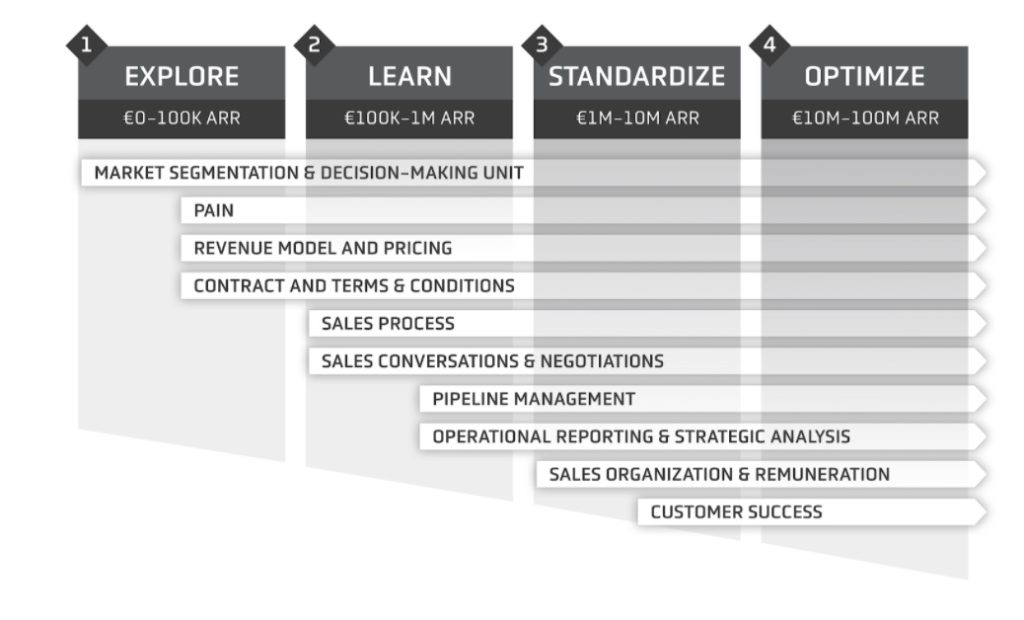
Only you as a founder are in the central position in your startup, which is necessary for successful sales in the beginning. Only later will you need a sales organization to scale what you’ve started.
Sales is such an important area in your business. You can’t just hand it off to someone else. As a founder, you have to go through the process yourself to understand it. In the beginning, sales is a very entrepreneurial activity. How do you find someone with a need? How do you get contacts?
Mistake 2
Starting With a Market Segment That’s Too Large
Many founders start sales with the vision that their product can be useful for many different use cases. And many B2B startups are indeed active in many different industries at some point. But if you target too many different customers from the start, you’ll have a hard time finding a good product/market fit as well as customers.
When you have a hammer, everything around you looks like a nail. You start hammering away like crazy around you, hoping to hit those nails. But then the china shatters and you realize that what you hit wasn’t a nail at all. Still, there’s no way around it: you have to keep hammering to find the nail. That’s why early distribution is the founders’ job. Until you find the nail, that is, get a clear and consistent market response for your product, it doesn’t make sense to hire a sales team.
Mistake 3
Building a Product Without Constant Customer Feedback
Fortunately, this mistake has become rarer since many founders started using the Lean Startup methodology. But still, many teams (especially those with a technical background) spend too much time at their desks instead of going out and getting feedback from their customers.
What does feedback have to do with sales? When you ask someone to not only review your product but to buy it, you’re guaranteed to get honest feedback. A yes or no answer shows whether your product is so successful at alleviating “pain” that your customers will actually give you money for it.
When we were struggling to get ahead in our early days, Paul Graham of Y Combinator gave us some brilliant advice. He said, ‘Don’t spend 18 months building any features first. Instead, spend just a week calling users. Tell them you’re already offering all these features, and see what happens.’ This week became the most depressing week in our lives. Out of the 500 people we called, maybe five were interested in using our service.
Mistake 4
Charging Too Little
Pricing is a complex and often underestimated mechanism for adding value to a transaction. That’s why many founders initially charge too little for their product.
If your prices are too low, you’ll run into a number of problems. A low price signals that the value of your product is lower, which creates distrust among your buyers. And if your price doesn’t take into account the complex purchasing processes of your corporate customers, you risk your profitability.
Few B2B customers are put off by pricing (too) high. If everything else fits, you can always negotiate.
We started with a price level that was rather low and not very degressive. And so our sales team often reported customers reacting to our price with “Wow, that’s really cheap!”. This, along with the investment we’ve put into our product (we now have more than 200 people working in product and engineering to improve and expand functionality), has made us confident that we can charge higher prices. In addition, we have changed the packaging structure to offer customers more flexibility, for example through add-ons.
Mistake 5
Mistaking a Pilot For a Customer
When is a customer a customer? Many founders proudly tell their impatient investors about their first customer, when in reality they have only signed contracts for free pilot projects. Unfortunately, “death by 1000 pilot projects” is often the result. So make sure you’re not just talking to innovation departments — and design your contracts for long-term collaboration from the outset.
Until five or ten years ago, pilot projects were a great concept. The customer paid €5,000 or €10,000 and you knew they were serious about buying at some point. Today, every company has its digitization department, and their only job is to run pilots with startups — with no intention of ever buying. If your only customers are digitization departments without any line of business leaders involved, that’s a problem.
Mistake 6
Sticking With a Rigid Sales Process For Too Long
You can learn a lot from sales, especially from conversations with your customers. But you can only leverage those learnings if you have your processes set up for rapid iteration.
If you try to standardize your sales process too early (say, to delegate it to your team), you’ll miss valuable lessons for your product and process.
My advice to founders is to keep validating and re-evaluating the foundational pillars of your business by engaging with your customers.
Mistake 7
Not Pushing For a “No” Early Enough
Fearful of missing out on a deal, founders are often reluctant to push hard enough for a “no.” In other words, they don’t qualify their prospects thoroughly enough in the early stages of the sales process.
This way, you waste a lot of valuable resources on customers who are unlikely to sign a contract. At the same time, you’re not spending enough time with the more accessible candidates.
Every sales call I asked about, I always heard, “Great job! They’re really interested!” I got tired of hearing that. In sales, you have to push for a “no.” There’s like a real “no” percentage in the early days — if you don’t hear “no” often enough, you’re not pushing hard enough!
Mistake 8
Managing Sales From Your Gut
You can only manage what you measure. Unfortunately, many founders don’t manage their CRM databases professionally enough. To manage sales, they rely on how things “feel” at the moment (or what their sales managers believe) instead of the factual data.
Curiously, the problem with SaaS products is sometimes the opposite: data overload. If you can measure literally anything, what should you focus on? Too much data makes it hard to keep track of your sales process and pipeline.
I call it KYB – Know Your Business, which means the inputs to what you’re doing. If you don’t understand the relationship between inputs and outputs, there’s a good chance it’s going to work once but not be repeatable. And SaaS is all about that: how to make it repeatable and more efficient.
Mistake 9
Underestimating the Human Factor For Growth
Finding team members for sales is difficult — perhaps the most difficult challenge of all. How are you supposed to know who you want on your team? And will the people you hire today still be the best choice for your startup a year or two from now?
Almost all founders struggle with the question of how to build their sales organization. Our advice: get help from experienced advisors and investors in sales to make the right decisions. At a certain level of complexity, only first-hand experience counts.
Today, I wouldn’t hire people from big companies who know exactly where we should be in 10 years — but don’t know how to get there from here. I would only hire people who have also seen what our current phase looks like.
Mistake 10
Focus All Sales Resources On Acquiring New Customers
More customers mean more revenue, so you’re giving your all to keep growing your customer base. But what about your existing customers?
Many founders neglect the one segment of the market whose doors are already wide open for their offerings: long-time, happy customers.
We could double the business in the next year if I didn’t close a single new deal — just with new products for the seats we already sold today. That’s how important upselling is to sustainable and efficient growth.
The authors
Martin Giese & Matthias Hilpert
Martin is a business angel, startup coach, negotiation expert, and author of the "Startup-Finanzierung" books. Matthias is one of the top 30 angels backed by EIF in Germany and has studied Business, Philosophy, and Artificial Intelligence.

The books
This methodology with 24 steps and 15 tactics was created at MIT to help you translate your technology or idea into innovative new products. The books were designed for first-time and repeat entrepreneurs so that they can build great ventures.

